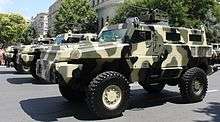Azerbaijani Armed Forces
The Armed Forces of Azerbaijan (Azerbaijani: Azərbaycan Silahlı Qüvvələri) were re-established according to the Law of the Republic of Azerbaijan on the Armed Forces from 9 October 1991.[5] The Azerbaijan Democratic Republic (ADR) had originally formed its own armed forces from 26 June 1918. However these were dissolved after Azerbaijan was absorbed into the Soviet Union as the Azerbaijan Soviet Socialist Republic from 28 April 1920. After the Soviet Union dissolved in 1991–92 the armed forces were reformed based on Soviet bases and equipment left on Azeri soil.
| Armed Forces of Azerbaijan | |
|---|---|
| Azərbaycan Silahlı Qüvvələri | |
 Coat of arms of the Azerbaijan Armed Forces | |
| Founded | 26 June 1918 |
| Current form | 9 October 1991 |
| Service branches | |
| Headquarters | Baku |
| Leadership | |
| Commander-in-Chief | President Ilham Aliyev |
| Defence Minister | Colonel-General Zakir Hasanov |
| Chief of Staff | Colonel-General Najmaddin Sadigov |
| Manpower | |
| Military age | 18–35 years (Regular) |
| Conscription | 12–18 months for ground forces[1] |
| Active personnel | 126,000[2] |
| Expenditures | |
| Budget | $2.267 billion (2020)[3] |
| Percent of GDP | 5% |
| Industry | |
| Domestic suppliers | Azerbaijan Defense Industry |
| Foreign suppliers | |
| Related articles | |
| History | Military history of Azerbaijan Azerbaijan Democratic Republic Armenian–Azerbaijani War (1918–1920) Battle of Baku (1918) Azerbaijan during World War II Nagorno-Karabakh War (1991–1994) 2016 Nagorno-Karabakh clashes |
| Ranks | Military ranks of Azerbaijan |
The armed forces have three branches: the Azerbaijani Land Forces, the Azerbaijani Air and Air Defence Force, and the Azerbaijani Navy.[6] Associated forces include the Azerbaijani National Guard, the Internal Troops of Azerbaijan, and the State Border Service, which can be involved in state defense under certain circumstances.
According to the Azerbaijani media sources the military expenditures of Azerbaijan for 2009 were set at $2.46 billion USD,[7] however according to Stockholm International Peace Research Institute, only $1.473 billion was spent in that year.[8] IISS also suggests that the defence budget in 2009 was $1.5 billion.[2] The Ministry of Defence Industry of Azerbaijan supervises the design, manufacturing, regulation and maintenance of military equipment. In the future, Azerbaijan hopes to start building tanks, armored vehicles, military planes and military helicopters.[9][10][11]
The incumbent Minister of Defence of Azerbaijan is Colonel General Zakir Hasanov, who succeeded Safar Abiyev.
Overview
Since the fall of the Soviet Union, Azerbaijan has been trying to further develop its armed forces into a professional, well trained, and mobile military. Azerbaijan has been undergoing extensive modernization and capacity expanding programs, with the military budget increasing from around $300 million in 2005 to $2.46 billion in 2009.[12] The total armed forces number 56,840 men in the land forces, 7,900 men in the air force and air defence force, and 2,200 men in the navy.[2] There are also 19,500 personnel in the National Guard, State Border Service, and Internal Troops.[13] In addition, there are 300,000 former service personnel who have had military service in the last 15 years.[14] The military hardware of Azerbaijan consists of 220 main battle tanks, an additional 162 T-80's were acquired between 2005 and 2010,[15] 595 armored combat vehicles and 270 artillery systems. The air force has about 106 aircraft and 35 helicopters.[16]
Azerbaijan has acceded to the Nuclear Non-Proliferation Treaty as a non-nuclear weapons state. Azerbaijan participates in NATO's Partnership for Peace. Azerbaijan joined the multi-national force in 2003. It sent 150 troops to Iraq, and later troops to Kosovo. Azeri troops are still serving in Afghanistan.
Despite the rise in Azerbaijan's defence budget,[17] the armed forces were assessed in 2008 as not having a high state of battle readiness and being ill-prepared for wide scale combat operations.[18]
However, in 2017 Global Firepower ranked Azerbaijan 59th among 127 countries for its military strength.[19] It was the best performance among the countries of South Caucasus.
Today 'National Hero of Azerbaijan' is the highest national title in the country, awarded for outstanding services of national importance to Azerbaijan in defense, as well as other deeds in other spheres.
History of the Azerbaijani military
Azerbaijan Democratic Republic

The history of the modern Azerbaijan army dates back to Azerbaijan Democratic Republic in 1918, when the Armed Forces of Azerbaijan Republic were created on 26 June 1918. First de facto Minister of Defense of ADR was Dr. Khosrov bey Sultanov. When the Ministry was formally established Gen. Samedbey Mehmandarov became the minister, and then Lt-Gen. Ali-Agha Shikhlinski his deputy. Chiefs of Staff of ADR Army were Lt-Gen. Maciej Sulkiewicz (March 1919 – 10 December 1919) and Maj-Gen. Abdulhamid bey Gaitabashi (10 December 1919 – April 1920).[20][21]
The Red Army invaded Azerbaijan on 28 April 1920. Although the bulk of the newly formed Azerbaijani army was engaged in putting down an Armenian revolt that had just broken out in Karabakh, the Azeris did not surrender their brief independence of 1918–20 quickly or easily. As many as 20,000 of the total 30,000 soldiers died resisting what was effectively a Russian reconquest.[22] The national Army of Azerbaijan was abolished by the Bolshevik government, 15 of the 21 army generals were executed by the Bolsheviks.[20]
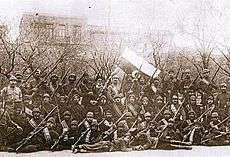
World War II
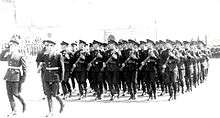
During World War II, Azerbaijan played a crucial role in the strategic energy policy of Soviet Union. Much of the Soviet Union's oil on the Eastern Front was supplied by Baku. By a decree of the Supreme Soviet of the USSR in February 1942, the commitment of more than 500 workers and employees of the oil industry of Azerbaijan was recognised with orders and medals. Operation Edelweiss carried out by the German Wehrmacht targeted Baku because of the importance of its oil fields to the USSR.[23] Some 800,000 Azerbaijanis fought within the ranks of the Soviet Army of which 400,000 died. Azeri national formations of the Red Army included the 223rd, 227th, 396th, 402nd, and 416th Rifle Divisions. Azeri Major-General Hazi Aslanov was awarded a second Hero of the Soviet Union after a long post-war fight for recognition of his accomplishments.
Dissolution of the Soviet armed forces
During the Cold War, Azerbaijan had been the deployment area of units of the Soviet 4th Army whose principle formations in 1988 included four motor rifle divisions (23rd Guards, 60th, 75th, and 295th).[24] The 75th Motor Rifle Division was isolated in Nakhichevan. The 4th Army also included missile and air defense brigades and artillery and rocket regiments. The 75th Division's stores and equipment were apparently transferred to the Nakhichevan authorities.[25] Azerbaijan also hosted the 49th Arsenal of the Soviet Main Agency of Missiles and Artillery, which contained over 7,000 train-car loads of ammunition to the excess of one billion units.
The first president of Azerbaijan, Ayaz Mutallibov, did not wish to build an independent army, wanting to rely instead largely on Soviet troops. Even when the Parliament decided that an army should be formed in September 1991, disagreements between the government and the opposition Azerbaijani Popular Front Party impeded creation of a unified force.[26] Around this time, the first unit of the new army was formed on the basis of the 18–110 military unit of mechanized infantry of the Soviet Ground Forces (probably part of the 4th Army) located in Shikhov, south of Baku.[27] At the time of the parliamentary decision, Lieutenant-General Valeh Barshadli became the first Minister of Defense of Azerbaijan, from 5 September to 11 December 1991.[28] Later from May to 4 September 1992 he served as Chief of General Staff of Azerbaijani Armed Forces.
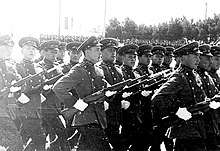
In summer 1992, the nascent Defense Ministry received a resolution by the Azerbaijani president on the takeover of units and formations in Azerbaijani territory. It then forwarded an ultimatum to Moscow demanding control over vehicles and armaments of the 135th and 139th Motor Rifle Regiments of the 295th Motor Rifle Division.[29] In July 1992, Azerbaijan ratified the Treaty on Conventional Armed Forces in Europe (CFE), which establishes comprehensive limits on key categories of conventional military equipment. Azerbaijan approved the CFE flank agreement in May 1997.
The transfer of the property of the 4th Army (except for part of the property of the 366th Motor Rifle Regiment of the 23rd Guards Motor Rifle Division captured by Armenian armed formations in 1992 during the regiment's withdrawal from Stepanakert) and the 49th arsenal was completed in 1992. Thus, by the end of 1992, Azerbaijan received arms and military hardware sufficient for approximately four motor rifle divisions with prescribed army units. It also inherited naval ships. There are also reports that 50 combat aircraft from the disbanded 19th Army of the Soviet Air Defence Forces came under Azeri control.
The Azeri armed forces took a series of devastating defeats by Armenian forces[30] during the 1992–1994 Nagorno-Karabakh War, which resulted in the loss of control of Nagorno-Karabakh proper and seven surrounding rayons, comprising roughly 20%[31][32][33][34] of the territory of Azerbaijan. Azerbaijani sources insist that Armenian victory was largely due to military help from Russia and the wealthy Armenian diaspora. Armenians partially deny the allegation, claiming that Russian side was equally supplying Armenian and Azerbaijani sides with weapons and mercenaries. During the war, the Azeri armed forces were also aided by Turkish military advisers, and Russian, Ukrainian, Chechen and Afghan mercenaries.
Non-combat deaths
A number of Azerbaijani human rights groups have been tracking non-combat deaths and have noted an upward trend. Based on Defense Ministry statistics that had not been released to the public, the Group of Monitoring Compliance with Human Rights in the Army (GMCHRA) has recorded the deaths of 76 soldiers to date in non-combat incidents for 2011, and the injury of 91 others. In comparison, there were 62 non-combat deaths and 71 cases of injury in 2010. The string of non-combat deaths raises questions about the reform progress of the military. Factors behind the deaths include bullying, hazing, and the systemic corruption within the Azeri military.[35]
Commanders
Ministers of Defense of Azerbaijan
Azerbaijan Democratic Republic
- General Khosrov bey Sultanov (27 May 1918 – 11 June 1918)
- Fatali Khan Khoyski (18 November 1918 – 25 December 1918)
- Samad bey Mehmandarov (25 December 1918 – 1 April 1920)
Republic of Azerbaijan
After Lt Gen Barshadli became Chief of General Staff, subsequent defense ministers from 1992 have included:
- Lieutenant General Valeh Barshadly (5 September 1991 – 11 December 1991
- Major General Tajaddin Mehdiyev (11 December 1991 – 17 February 1992)
- Shahin Musayev (Acting) (17 February 1992 – 24 February 1992)
- Interior Troops Colonel Tahir Aliyev (24 February 1992 – 16 March 1992)
- Rahim Gaziyev (17 March 1992 – 20 February 1993)
- Major General Dadash Rzayev (21 February 1993 – 17 June 1993)
- Colonel General Safar Abiyev (Acting) (17 June 1993 – 20 August 1993)
- Major General Vahid Musayev (Acting) (August 1993 – 25 August 1993)
- Lieutenant General Mammadrafi Mammadov (2 September 1993 – 6 February 1995)
- Colonel General Safar Abiyev (6 February 1995 – 28 October 2013)
- Colonel General Zakir Hasanov (since 22 October 2013)
Land forces
The Azerbaijani Land Forces number 85,000 strong, according to UK Advanced Research and Assessment Group estimates.[13] The 2,500 men of the National Guard are also part of the ground forces. In addition, there are 300,000 former service personnel who have had military service in the last 15 years.[14] Other paramilitary agencies consist of Interior Ministry Internal Troops of Azerbaijan, 12,000 strong, and the land component of the State Border Service, 5,000 strong.[13]
Azerbaijan has signed numerous contracts to strengthen its armed forces and to train its military with Turkey's assistance. Over the last 15 years, Azerbaijan has been preparing its military for possible action against Armenian forces in Nagorno-Karabakh.
Organization
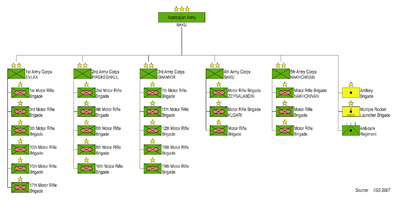
The Land Forces consist of five army corps:[13]
- 1st Army Corps also known as Evlax Army Corps (concentrated near Ganja)
- 2nd Army Corps also known as Pirekeshkul Army Corps (concentrated against Armenian controlled territories and part is deployed on the Azerbaijan-Iranian border)
- 3rd Army Corps also known as Shamkir Army Corps (concentrated against Armenian controlled territories)
- 4th Army Corps also known as Baku Army Corps (covers Absheron Peninsula and the coast)
- 5th Army Corps also known as Nakhchivan Army Corps (deployed in Nakhichevan)
The Land Forces include 23 motor rifle brigades, an artillery brigade, a multiple rocket launcher brigade, and an anti-tank regiment.[13] The IISS Military Balance reported in 2007 that the Land Forces had an estimated 40 SA-13 Gopher, SA-4 Ganef, and SA-8 Gecko air defence missile systems, with '80–240 eff.' to support the army in the battlefield. (IISS 2007, p. 157)
The Peacekeeping forces of Azerbaijan are mostly supplied from the Land Forces, though the Internal Troops of Azerbaijan do also supply some. As of March 2011, 94 peacekeepers were deployed with the International Security Assistance Force (ISAF) in Afghanistan.[36] In the past, it also actively supported the peacekeeping operation in Kosovo and Iraq.
The Azeri peacekeeping unit deployed in Iraq consisted of 14 officers, 16 sergeants and 120 privates, a total of 150 troops. The unit secured the hydroelectric power station and reservoir in Al Haditha from August 2003. In December 2008, Azerbaijan withdrew the unit from Iraq.
Reportedly in December 2014 Azerbaijan created the 6th Army Corps in Nakhchivan. Karam Mustafayev became commander of the Special 6th Army Corps. The Special 6th Army Corps has been created based on the Nakhchivan 5th Army Corps to strengthen defense capability of Nakhchivan Autonomous Republic, increase of combat capability of military units and formations of the Armed Forces, improve central control, reports quoting the Defence Ministry said.
Air forces
The Azerbaijani Air and Air Defence Force is a single unified service branch.[6] Some 8,000 men serve in the air force and air defence force.[13]
The Azerbaijani Air and Air Defence Force has around 106 aircraft and 35 helicopters.[16] The country has four major airbases. Nasosnaya (air base) has fighters, Kyurdamir Air Base a bomber regiment, Ganja Air Base transports, and Baku Kala Air Base the helicopter unit. There are also four other airbases which do not appear to have aircraft based there. These are Dollyar Air Base, Nakhichevan Airport, Sanqacal Air Base, and Sitalcay Air Base.
The Azeri Air Force uses MiG-21, MiG-23, Su-24 and Su-25 aircraft, as well as the MiG-29 purchased from Ukraine in 2006 and Il-76 transport aircraft. The MiG-29 have been designated as the standard aircraft for the AzAF.[37] Azerbaijan is holding talks with either the People's Republic of China or Pakistan to purchase JF-17 Thunder aircraft.[38] MiG-25s previously in service have been retired seemingly in the 2007–09 period.
Azerbaijan's helicopter force is concentrated at Baku Kala Air Base and according to the IISS consists of a single regiment with around 14–15 Mi-24, 12–13 Mi-8 and 7 Mi-2. Jane's Information Group and the IISS give figures which agree with only a single aircraft's difference.[39] Recently, end of 2010 Russian Rosvertol announced that Azerbaijan armed forces signed a deal for 24 pieces of Mi-35M (Hind-E) gunships what would further enhance the Azeri ground attack formations.[40][41]
The Air Force has L-29 and L-39 advanced training aircraft in store. The Azerbaijan Border Guard and Voluntary Society of Defense, Patriotism and Sport have Yakovlev light training aircraft.
Air defense
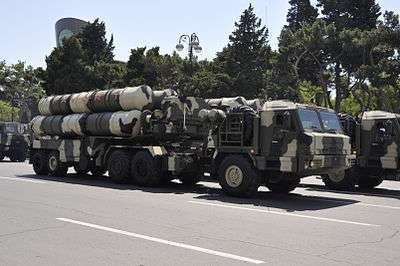
Azerbaijan has missile and radar systems intended to defend Azeri airspace. There are at least 2 divisions of S-300PMU2.[42] Thereby the country has one of the most capable SAM surface-to-air missile system in the region.[43][44] Azerbaijan also operates two S-200 (SA-5 GAMMON) batteries near Baku and Mingachevir; the S-300PMU-2 represents a logical replacement for these systems offering coverage of the majority of the nation.[44] The country also has about 100 NATO designated SA-2 Guideline (original name S-75), SA-3 Goa (S-125 Pechora-2M), and the SA-5 Gammon (S-200) are in static installations.[45] These may be around Baku and the central part to cover the whole Azeri aerospace.
However, August 2011 investigations shows that after purchase of S-300 surface-to-air missiles, the largest apparent gap in Azerbaijan's air defense system may have been filled.[46]
Also in Azerbaijan there was a former Soviet early warning radar. The Gabala Radar Station was a bistatic phased-array installation, operated by the Russian Space Forces. The contract was signed in 2002 and was due to expire in 2012 where it was to be given back to the Azerbaijani government. The contract costed Russia $7 million per year. The radar station had a range of up to 6,000 kilometres (3,700 miles), and was designed to detect intercontinental ballistic missile launches as far as from the Indian Ocean. In December 2012 Russia announced that negotiations had been unsuccessful and that they had stopped using the radar station.[47][48] The site was given back to Azerbaijan[49] and all the equipment dismantled and transported to Russia.[50] Nowadays, Russia covers the area from the Armavir Radar Station.
Training and education
Azerbaijani pilots are trained in the Azerbaijan Air Force School and then develop their skills in operational units. Azerbaijan has an experience exchange with Turkey, Ukraine, the United States and a number of NATO countries. The Turkish Air Force School has a great role in the training of Azeri military pilots. Azerbaijani pilots are also trained in Ukraine's Pilot Training School.[51]
Navy
The main naval base of the Soviet Union in the Caspian Sea was based in Baku. When the Soviet Union collapsed, Azerbaijan inherited the naval base and parts of the Caspian Fleet.[52] The Azerbaijan Navy has about 2,200 personnel.[53] The navy has a Petya class light frigate, Qusar (G 121), and a number of patrol craft, including one Turk class, Araz, P 223, one Brya (Project 722) class, P 218, one Shelon (Project 1388M) class, P 212, one Poluchat class (Project 368), P 219, one Luga class (Project 888), T 710, and four Petrushka (Polish UK-3 class), P 213, P 214, P 215, and P 216. There are four minesweepers consisting of 2 Sonya class minesweeper and 2 Yevgenya class minesweepers. (Jane's Fighting Ships 2010)
The Navy is also attributed with 5 landing craft, 3 Polnochny and 2 Vydra,(IISS 2007) plus three research ships, 1 Project 10470, A 671, ex Svyaga, 1 Balerian Uryvayev class survey vessel (AG) and one Vadim Popov class survey vessel (AG).
The U.S. Navy has helped train the Azeri Navy. There is also an agreement to provide US support to refurbish Azeri warships in the Caspian Sea. In 2006, the US Government donated 3 motorboats to the Azerbaijani navy. In 2007 an agreement between Azeri Navy and a US military company was concluded, which stated that a part of the Azeri Navy would be equipped with advanced laser marksmanship systems. The US company specialists were also to give training on the use of the new equipment.[54] A number of separate U.S. programmes are underway under the Caspian Guard Initiative, focused mostly on enhancing Azerbaijani and Kazakh maritime border security.
In May 2011, President of the State Oil Company of Azerbaijan Republic Rovnag Abdullayev stated that Azerbaijan to start production of national warships after 2013.[55][56]
Special forces
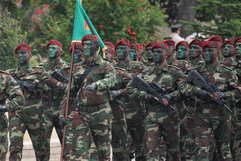
The Naval Intelligence of Azerbaijan maintains the 641st Special Warfare Naval Unit. The special forces were trained by the U.S. Navy SEALs[57] Unit 641 has several midget submarines such as Triton-1M and Triton 2 at their disposal as well as underwater tool motion for individual divers. The special unit is composed of 3 reconnaissance groups, 2 groups for mountainous warfare and one diving group. Obligatory training includes parachute jumping day and night, on land and on water.[52][58]
Defense industry
The Ministry of Defence Industry of Azerbaijan directs domestic military supplies for Azerbaijan. It was established in 2005. The Defence Industries Ministry subsumed the State Department for Military Industry and for Armaments and the Military Science Center, each of which was formerly a separate agency within the Azerbaijani Defense Ministry.
The defense industry has emerged as an autonomous entity with a growing defense production capability. The ministry is cooperating with the defense sectors of Ukraine, Belarus and Pakistan.[60] Along with other contracts, Azerbaijani defence industries and Turkish companies, Azerbaijan will produce 40mm revolver grenade launchers, 107mm and 122mm MLRS systems, Cobra 4×4 vehicles and joint modernization of BTR vehicles in Baku.[61][62][63][64]
The major military companies of Azerbaijan are:
- RPE Iglim, aviation and shipbuilding
- Radiogurashdirma, communication means and radio-electronic
- RPE Neftgazavtomat, devices and automation systems for monitoring technological processes
- RPE Automatic Lines, non-standard equipment and products for application in electrotechnical and machine engineering
- Avia-Agregat, multi-purpose aviation equipment, various airdrome conditioners, universal container of board conductor, air-to-air radiators, fuel-oil, air-to-air heat exchangers and ventilators[65]
In early 2008, reports indicated that an agreement with Turkey had been signed which would lead to Azerbaijan producing armoured personnel carriers, infantry fighting vehicles, and small calibre artillery pieces.[9]
Educational system
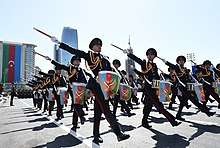

The military education system in Azerbaijan contributes to the strength of the armed forces by ensuring the loyalty of cadets to security and defense of the Republic of Azerbaijan. The purpose of these military institutions is to train soldiers, officers, and non-commissioned officers to have independent and creative thinking and commitment to the Azerbaijani people and the government. military education in the Azerbaijani Armed Forces have been described as either being Secondary education, Further education, or Higher education.[66]
List of military institutions
- Military academies
- War College of the Armed Forces
- Training and Education Center of the Armed Forces
- Azerbaijan Higher Military Academy
- Azerbaijan Higher Naval Academy (former independent institution)
- Azerbaijan High Military Aviation School (former independent institution)
- Secondary educational institutions
- Secondary Military Medical School of Azerbaijan
- Military lyceums
- Jamshid Nakhchivanski Military Lyceum
- Heydar Aliyev Military Lyceum
International cooperation
Azerbaijan cooperates with about 60 countries in the military-technical sphere and has an agreement on military-technical cooperation with more than 30 countries.[67]
Turkey
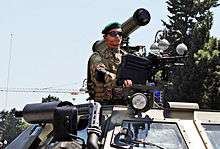
In December 2009 an agreement on military assistance was signed by Turkey and Azerbaijan. The agreement envisions Ankara's supplying Azerbaijan with weapons, military equipment and, if necessary, soldiers in case war with Armenia over Karabakh resumes.[68]
Turkey has provided Azerbaijan with infantry weapons, tactical vehicles (jeeps, trucks, etc.) professional training, military organization, technology transfer, licensed military hardware production and other services. Due to help from Turkish specialists and instructors, thousands of Azerbaijani officers have been trained to western standards.[69]
The military position as international importance of Azerbaijan increased with agreement between Azerbaijan and Turkey on the participation an Azerbaijani peacekeeping platoon in the staff of Turkish battalion in Kosovo.[70]
Since 1992 Azerbaijan and Turkey have signed more than 100 military protocols, some of the major protocols include:[71]
- Cooperation of staff members
- National security cooperation in the topographical area
- Forming and training of profession school of forces kind of Baku
- Carrying out of the material and technical purchasing
- Military industry cooperation
- Development of the 5th Army Corps also known as Nakhchivan Army Corps in Nakhchivan[72]
- Cooperation in the area of military history, military archives and museum work and military publication
- Assistance on training, material and technical between the Azerbaijan Border Guard and the Turkish Armed Forces.
- Long-term economical and military cooperation and application of the financial aid
- Application of material and technical provision
In May 2011, Azerbaijan had discussed the purchase of long-range rockets from two Chinese companies, the minister of the defence industry has said. Other arms deals were signed with Turkey. Turkish Defence Minister Vecdi Gonul and Yaver Jamalov signed a protocol of intent on future joint production of two types of output – 107-mm rockets and the national rifle, possibly the Mehmetçik-1. A protocol of intent was signed the same day with the Mechanical and Chemical Industry Corporation MKEK on the joint production of 120-mm mortar launchers. This project will come into force in a few months time. Agreement has also been reached with Turkish company Aselsan on the production of some types of defence output in Azerbaijan, specifically the latest types of weapons' sights. These projects will probably happen in the near future too.[73] Recently, Turkish defense industries secretariat told that an export version of the T-155 Firtina self-propelled howitser is almost done and could start production. T-155 has been powered by a German MTU power pack, which restricts the sale to some countries like Azerbaijan. The Turkish manufacturer MKEK, has announced that they have found an alternate supplier for the power pack where Azerbaijan showed interest to buy the high tech, more capable 155mm 52 caliber from Turkish authorities.
United States

Section 907 of the United States Freedom Support Act bans any kind of direct United States aid to the Azerbaijani government. Since a waiver was made in 2001 there has been extensive U.S. military cooperation with Azerbaijan. This has included Special Forces and naval aid, consultations with United States European Command, and linkages through the U.S. National Guard State Partnership Program.
On 19 May 2006, Azerbaijani Defense Minister Safar Abiyev and the then commander of United States Air Forces in Europe General Tom Hobbins met in Baku to discuss military cooperation. He said the objective of his visit was to become familiar with the state of Azerbaijani armed forces.[74] Hobbins pointed to the progress made in the NATO-Azerbaijan relations, saying that the successful implementation of the NATO Partnership for Peace program in Azerbaijan has brought the country even closer to the alliance. He said that the two countries' air forces will expand cooperation.[75]
The U.S. state of Oklahoma is linked with Azerbaijan through the U.S. National Guard State Partnership Program (SPP). Oklahoma National Guard troops have been sent on training and humanitarian missions to Baku.
Russia
Russia is Azerbaijan's main arms supplier. "As of today, military and technical cooperation with Russia is measured at $4 billion and it tends to grow further," President Ilham Aliyev said after meeting with Russian President Vladimir Putin in Baku in 2013.[76]
Israel
Azerbaijan and Israel cooperate on numerous areas of the defense industry. Azerbaijan has shown great interest in Israeli technology over the years. In particular, an agreement was reached over the construction of the factory of intelligence and combat drones in Azerbaijan.[77][78]
The Israeli defense company Elta Systems Ltd has had cooperation from Azerbaijan in building the TecSAR reconnaissance satellite system, which can take high-definition photos of ground surfaces in all weather conditions.[79][80] According to Azerbaijani military experts, the TecSAR system will be indispensable for military operations in the mountainous terrains of Azerbaijan.[77]
As of June 2009, Israel and Azerbaijan had been negotiating on the production of Namer armoured infantry fighting vehicles in Azerbaijan.[81] There is no further information as to whether any agreement has been made.
Both countries treat a nuclear I.R. Iran as security threat.
NATO
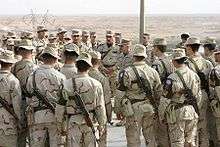
The North Atlantic Treaty Organization (NATO) and Azerbaijan actively cooperate on defence institutional reforms and have developed practical cooperation in many other areas. Azerbaijan's Individual Partnership Action Plan (IPAP) and its Partnership for Peace (PfP) linkages lay out the programme of cooperation between Azerbaijan and NATO.
The Azerbaijani government has however delayed implementing IPAP-recommended reforms, however, in part at least because no decision had been taken to seek NATO membership. This is because Azerbaijan's foreign policy 'seeks to balance interests with the U.S., EU, Russia and Iran.'[82]
According to a NATO diplomatic source some key officials at NATO headquarters in Brussels were pushing hard for engaging Azerbaijan on the membership question. "Turkey, Romania, Italy, Poland, the United Kingdom and the Baltic states," are among the member-states also backing a fast track for Azerbaijan's NATO membership.[83]
However, Azerbaijan made its policy of not being aligned with a geopolitical/military structure official when it became a full member of the Non-Aligned Movement in 2011.
There is also a limited amount of military cooperation with the other countries of GUAM: Georgia, Ukraine, Azerbaijan, and Moldova.[84]
References
- "Azerbaijan - European Bureau for Conscientious Objection". www.ebco-beoc.org. Archived from the original on 15 January 2015. Retrieved 15 January 2015.
- The Military Balance 2010. London: Routledge for the IISS. 2010. p. 176. ISBN 1-85743-557-5.
- https://www.globalsecurity.org/military/world/azerbaijan/budget.htm
- "Canadian defence deal with Azerbaijan raises new questions about arms export controls - CBC News". Archived from the original on 2 October 2017. Retrieved 17 October 2017.
- "Official web-site of President of Azerbaijan Republic". en.president.az. Archived from the original on 30 May 2012. Retrieved 6 March 2018.
- Jane's Sentinel Security Assessments – Russia and the CIS: Air Force, dated 18 June 2009, and "World Defence Almanac". Military Technology. Bonn, Germany: Monch Publishing Group. XXXII (1): 244–245. 2008. ISSN 0722-3226.
- "Gov't allots over $2bn for 2009 defense spending". AzerNEWS. 12 November 2008. Archived from the original on 6 July 2011. Retrieved 12 November 2008.
- Stockholm International Peace Research Institute The SIPRI Military Expenditure Database Archived 25 July 2011 at the Wayback Machine
- "Azerbaijan manufacturing arms". 26 January 2008. Archived from the original on 30 May 2012.
- "Azerbaijan to manufacture its own aircraft and helicopters". Archived from the original on 23 March 2009. Retrieved 25 September 2008.
- "Azerbaijan will be unable to produce competitive military technology in the next five years". Archived from the original on 23 March 2009. Retrieved 26 September 2008. and "Azerbaijan to produce tanks, aviation bombs and pilotless vehicles in 2009". Archived from the original on 19 September 2010. Retrieved 7 June 2010.
- "Azerbaijan announces 53 pct rise in army spending". Reuters. 15 April 2008. Archived from the original on 26 July 2009. Retrieved 30 June 2017.
- C. W. Blandy Azerbaijan: Is War Over Nagornyy Karabakh a Realistic Option? Advanced Research and Assessment Group. Caucasus Series 08/17. — Defence Academy of the United Kingdom, 2008, p.12 Archived 10 May 2011 at the Wayback Machine
- IISS (2007). The Military Balance 2007. London: Routledge for the IISS. p. 157. ISBN 978-1-85743-437-8.
- Azerbaijan is second big purchaser of tanks from Russia, Ukraine and Belarus in 2005–2010 Archived 7 April 2012 at the Wayback Machine
- IISS (2007). The Military Balance 2007. London: Routledge for the IISS. p. 158. ISBN 978-1-85743-437-8. The IISS list 37 fighter aircraft, 15 fighter-ground attack aircraft, four transport aircraft, 50 training aircraft (including five combat capable trainers), 15 attack helicopters, and 20 transport helicopters
- Blandy, 'Azerbaijan: Is War Over Nagornyy Karabakh a Realistic Option?, 2008, p.6, quoting http://nvo.ng.ru/wars/2007-02-09/2_poroh.html Archived 3 February 2012 at the Wayback Machine Nezavisimoye Voyennoye Obozreniye 9 February 2007.
- Blandy, 2008, p.7
- "2017 World Military Powers". Archived from the original on 9 November 2014. Retrieved 30 April 2017.
- Azerbaijani Army marks 91 years Archived 25 February 2012 at the Wayback Machine
- "Azerbaijan marks Day of Armed Forces". Archived from the original on 29 June 2009. Retrieved 27 June 2009.
- Hugh Pope, "Sons of the conquerors: the rise of the Turkic world", New York: The Overlook Press, 2006, p. 116, ISBN 1-58567-804-X
- Swietochowski, Tadeusz(1995) Russia and Azerbaijan: A Borderland in Transition, Columbia University, p. 133.
- "4th Combined Arms Army". www.ww2.dk. Archived from the original on 11 December 2016. Retrieved 8 August 2016.
- See reference at 7th Guards Army article.
- International Crisis Group, Azerbaijan: Defence Sector Management and Reform Crisis Group Europe Briefing N°50, 29 October 2008, p.3
- "Azərbaycan Respublikası Müdafiə Nazirliyi. 1991-dən sonra" [Ministry of Defense of Azerbaijan Republic. Events after 1991]. Archived from the original on 5 July 2010. Retrieved 1 July 2010.
- "Azərbaycan Respublikası Müdafiə Nazirliyinin yaradılması haqqında AZƏRBAYCAN RESPUBLİKASI PREZİDENTİNİN FƏRMANI" [Order of President of Azerbaijan Republic on establishment of Ministry of Defense of Azerbaijan Republic]. Archived from the original on 9 October 2011. Retrieved 5 January 2011.
- Vladimir Petrov, How South Caucasus was armed Archived 24 October 2007 at the Wayback Machine, Centre for Analysis of Strategies and Technologies (Moscow, Russia)
- 1993 UN Security Council Resolutions on Nagorno-Karabakh
- Caucaso, Osservatorio Balcani e. "IDPs in Azerbaijan". Osservatorio Balcani e Caucaso (in Italian). Archived from the original on 20 September 2017. Retrieved 26 September 2017.
- "GENERAL ASSEMBLY ADOPTS RESOLUTION REAFFIRMING TERRITORIAL INTEGRITY OF AZERBAIJAN, DEMANDING WITHDRAWAL OF ALL ARMENIAN FORCES | Meetings Coverage and Press Releases". www.un.org. Archived from the original on 18 August 2015. Retrieved 26 September 2017.
- "Anglo Asian Mining PLC". www.angloasianmining.com. Archived from the original on 20 September 2017. Retrieved 26 September 2017.
- "The Ever-Thorny Azerbaijani-Armenian Dossier: A Territorial Dispute With Broad Regional Implications | Foreign Policy Journal". Foreign Policy Journal. 2 December 2014. Archived from the original on 20 September 2017. Retrieved 26 September 2017.
- "Azerbaijan: Non-Combat Deaths Put Military Reforms in Spotlight". EurasiaNet. 14 November 2011. Archived from the original on 28 January 2012. Retrieved 2 February 2012.
- "Archived copy" (PDF). Archived from the original (PDF) on 6 April 2011. Retrieved 13 April 2011.CS1 maint: archived copy as title (link)
- "Azerbaijan shows MIG-29 fighter jets". Archived from the original on 29 September 2007. Retrieved 3 April 2007.
- "China supplies FC-1 multipurpose fighters to Azerbaijan". news.am. Archived from the original on 2 April 2015. Retrieved 28 February 2015.
- Archived 28 September 2011 at the Wayback Machine
- "Azerbaijan Orders 24 Mi-35M Helicopter Gunships". Archived from the original on 5 March 2011. Retrieved 25 March 2011.
- "HeliHub.com Azerbaijan buys 24 Mi-35M attack helicopters". www.helihub.com. Archived from the original on 22 July 2011. Retrieved 25 March 2011.
- "HistoryofTruth.com - Armenian Allegations". Archived from the original on 11 June 2012. Retrieved 2 March 2012.
- "V1N7 August 2011.pdf".
- "Russia's Credibility And Its Military Sales To Azerbaijan". Archived from the original on 19 September 2011. Retrieved 23 August 2011.
- IISS Military Balance 2007, p. 158
- Kuchera, Joshua. "Analysis: Azerbaijan, Karabakh Well-Protected Against Air Attack; Armenia Less So". Eurasia.net. Archived from the original on 7 August 2011. Retrieved 4 August 2011.
- "Russia Confirms Pullout from Gabala Radar in Azerbaijan". RIA Novosti. 11 December 2012. Archived from the original on 31 August 2013. Retrieved 14 April 2013.
- "Russia's decision to close down Gabala radar station is final - Lavrov". Russia Beyond the Headlines. 23 January 2013. Retrieved 14 April 2013.
- "Габалинская РЛС теперь находится под контролем азербайджанских военных". www.ng.ru. Archived from the original on 31 December 2015. Retrieved 28 December 2015.
- "Габалу завлекают в турбизнес". Archived from the original on 10 October 2013. Retrieved 28 December 2015.
- Azerbaijan’s military aviation opportunities Archived 19 March 2012 at the Wayback Machine
- Константин Чуприн (31 August 2007). "В фарватере НАТО". NVO NG. Archived from the original on 12 January 2012.
- Jane's Fighting Ships, 2010, accessed February 2010. IISS 2007 attributes 2,000 personnel
- "Azerbaijan Navy to be equipped with laser devices". Archived from the original on 29 September 2007. Retrieved 4 May 2007.
- "Azerbaijan to produce warships". Archived from the original on 20 November 2011. Retrieved 9 May 2011.
- "Azerbaijan to produce ships". Archived from the original on 10 April 2011. Retrieved 9 May 2011.
- Donna Miles (10 June 2004). "Navy Special Ops Demos Training in Azerbaijan". American Forces Press Service (Press release). U.S. Department of Defense. Archived from the original on 30 September 2017.
- "Спецподразделения Азербайджана". Specnazopedia.Narod. 14 March 2010. Archived from the original on 25 April 2012.
- "Paramount Group". www.paramountgroup.biz. Archived from the original on 27 March 2010. Retrieved 16 March 2010.
- "Azerbaijan: Baku Signals New Determination For Defense Reform". RadioFreeEurope/RadioLiberty. Archived from the original on 10 April 2018. Retrieved 10 April 2018.
- "News.Az - Azerbaijan, Turkey to produce revolver grenade launchers". www.news.az. Archived from the original on 7 November 2010. Retrieved 29 December 2010.
- Azerbaijan’s Ministry of Defense Industry plans to assume several projects on technical modernization of Armed Forces Archived 2 April 2012 at the Wayback Machine
- "News.Az - Azerbaijan, Turkey sign contract on joint rocket production". www.news.az. Archived from the original on 8 November 2010. Retrieved 29 December 2010.
- Azerbaijani Defense Industry Ministry conducts negotiations with Turkish "Otokar" Company on production of armored vehicles Archived 25 March 2012 at the Wayback Machine
- Aircraft Repair Plant of Azerbaijan to be reconstructed Archived 15 February 2012 at the Wayback Machine
- "Archived copy". Archived from the original on 12 June 2018. Retrieved 11 June 2018.CS1 maint: archived copy as title (link)
- "Czech defense minister to visit Azerbaijan". Archived from the original on 6 July 2011. Retrieved 22 August 2009.
- "AzerNEWS". 6 July 2011. Archived from the original on 6 July 2011.CS1 maint: BOT: original-url status unknown (link)
- NATO, Azerbaijani troops part of the KFOR family Archived 21 June 2007 at the Wayback Machine
- Azerbaijan Ministry of Foreign Affairs, List of the military documents signed between the Republic of Turkey and Republic of Azerbaijan Archived 10 March 2012 at the Wayback Machine
- List of the military documents signed between the Republic of Turkey and Republic of Azerbaijan
- In 2001 between the Ministry of Defense of the Republic of Azerbaijan and the General Staff of the Republic of Turkey on development of Nakhchivan 5th army protocol
- "Azerbaijan to buy long-range rockets". Archived from the original on 15 May 2011. Retrieved 9 May 2011.
- NATO & Azerbaijan relations Archived 1 June 2006 at the Wayback Machine
- "Azerbaijan, USA discuss military cooperation". Archived from the original on 29 September 2007. Retrieved 19 May 2006.
- Azeri-Russian Arms Trade $4 Billion Amid Tension With Armenia Archived 19 January 2015 at the Wayback Machine By Zulfugar Agayev 13 August 2013
- "Israel rearms Azerbaijani army". Archived from the original on 28 July 2010. Retrieved 7 June 2010.
- Washington briefing: Israel, Azerbaijan to step up military cooperation Archived 24 June 2011 at the Wayback Machine
- "Eurasianet". www.eurasianet.org. Archived from the original on 5 May 2012. Retrieved 30 November 2009.
- Ninan Koshy, "India and Israel Eye Iran Archived 12 October 2009 at the Wayback Machine", Foreign Policy in Focus, 13 February 2008.
- Panarmenian.net panarmenian – Israel rearms Azerbaijani army Archived 28 July 2010 at the Wayback Machine, 30 June 2009
- International Crisis Group, Azerbaijan: Defence Sector Reform and Management, Europe Briefing No.50, Baku/Tblisi/Brussels, 29 October 2008, p.1
- "Eurasianet". www.eurasianet.org. Archived from the original on 6 June 2009. Retrieved 9 August 2009.
- Военное сотрудничество между постсоветскими государствами Archived 21 July 2011 at the Wayback Machine (in Russian)


Further reading
- U.S. Army War College Center for Strategic Leadership, Transformation of the Azerbaijani Armed Forces, October 2008
External links
| Wikimedia Commons has media related to Military of Azerbaijan. |
